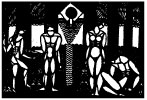| |
The second play on the fourth bill of the 1918-19 season was The Squealer by Mary F. Barber,(1) which John Corbin calls “an interesting but entirely conventional play,”(2) and Broun states that it “might have been made highly dramatic,”(3)
implying that in this production it was not. Set in Pennsylvania in one of the “Company Houses” of a mining village, it is a story about the Molly Maguires, Irish miners in the 1860s who organized strikes and murderous raids to protest their oppressive working and living conditions. Mrs. Kerrigan’s husband is one of these men, convicted for killing a boss, and she worriedly awaits word of his pardon or his hanging. It seems a “squealer” has turned in the men, at whom she voices her disgust and for her husband’s fellow conspirators for involving him. When her husband, Jim, surprises her and covertly arrives home, she is confused as to how he has escaped. When a fellow Molly comes by their home, Jim hides and pleads with his wife to not reveal his presence. When the visitor tells her of new arrests induced by more squealing, she becomes upset, thinking that perhaps Father Connor, who has visited her earlier, might be the one. After the visitor departs, Jim pleads with his wife to leave with him to a new job he’s been offered in the West. This arouses her suspicions and she finally realizes her husband is the squealer and she rejects him. He asks her, “You’d sooner see me hung?” and she answers “I would.” Shouts of approaching men are then heard and, in fear, she tells Jim to leave, but as the curtain drops, he tells her, “Not alone, Marge.”
This decidedly ambiguous ending led critic Corbin to presume that Mrs. Kerrigan remains loyal to the gang and that she allows Jim to be captured and presumably killed. Broun sees the ending as “the only novel turn” of the play, but calls it “hardly an improvement, since the author allows her little play to go into a stalemate,” and shows his preference for something more definitive by adding “Affairs in life do get into just such snarls sometimes, but it is perhaps a justifiable convention of the drama that a play must go on to a finish.”(4) Corbin feels that, like The Baby Carriage, “the play seems to aim at simplicity and sincerity rather than at dramatic climax.” While he applauds this effort, he adds “but it is possible that the desired effect of truth might have been even more fully realized with a greater degree of technical skill.”(5)
The cast was led by Ida Rauh as Marge Kerrigan, who Corbin says “disclosed a very considerable emotional power,” and of whom Broun says gave a “sincere, strong and shrewdly modulated performance.” The others, however, are lumped by Corbin into a comment about the Provincetown Players’ acting in general, stating their “lack of technical skill is unmistakable; but they also have a full share of the better part of the amateur, simplicity and sincerity.”(6) Others in the cast were the two Molly Maguires, Charles Garland Kemper as Malloy and Frederick Ward Roege as Kelly; Father Connor was played by Robert Edwards, and Jim Kerrigan was played by Lionel Moise. The play was directed by Edward J. Ballantine, who hadn’t been involved in the Players for quite some time.
© Jeff Kennedy, 2007.
(1) In her interview in the Morning Telegraph, Ida Rauh refers to the author as Mary F. Barber, not Mary H. Barber. Morning Telegraph,16 February 1919, sec. 2, cols. 1-5: 3. However, both Broun and Corbin in their reviews, as well as the bill’s program name her as Mary H. Barber. Sarlos in his diss. names her Mary Foster Barber, as does the Library of Congress, where the only known copy of this unpublished play exists.
(2) John Corbin, New York Times, 23 February 1919, sec IV, col 1-2: 2.
(3) Heywood Broun, New York Tribune, 23 February 1919, sec VII, col 1 & 2: 1.
(4) Robert Sarlos, Provincetown 255-56.
(5) Heywood Broun, New York Tribune, 23 February 1919, sec VII, col 1 & 2: 1.
(6) John Corbin, New York Times, 23 February 1919, sec IV, col 1-2: 2.
(7) John Corbin, New York Times, 23, February 1919, sec IV, col 1-2: 2.
|
